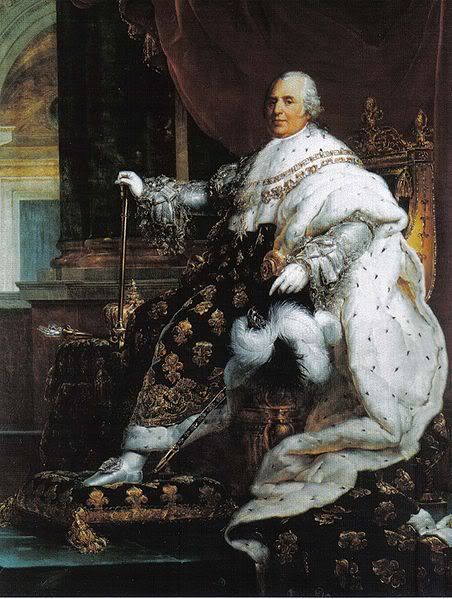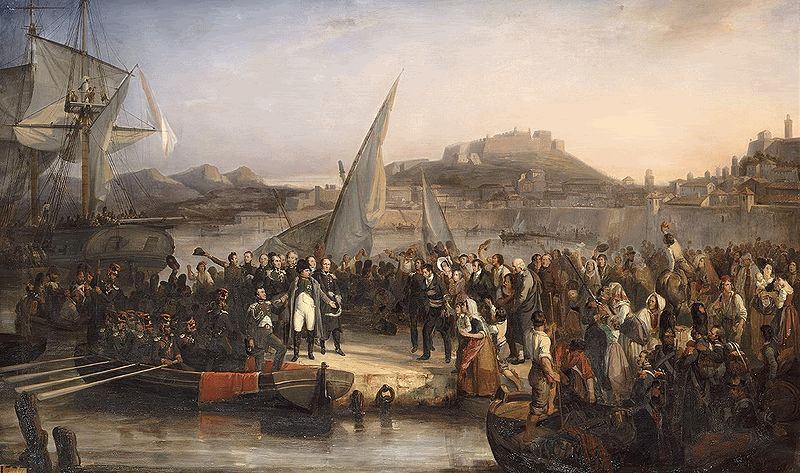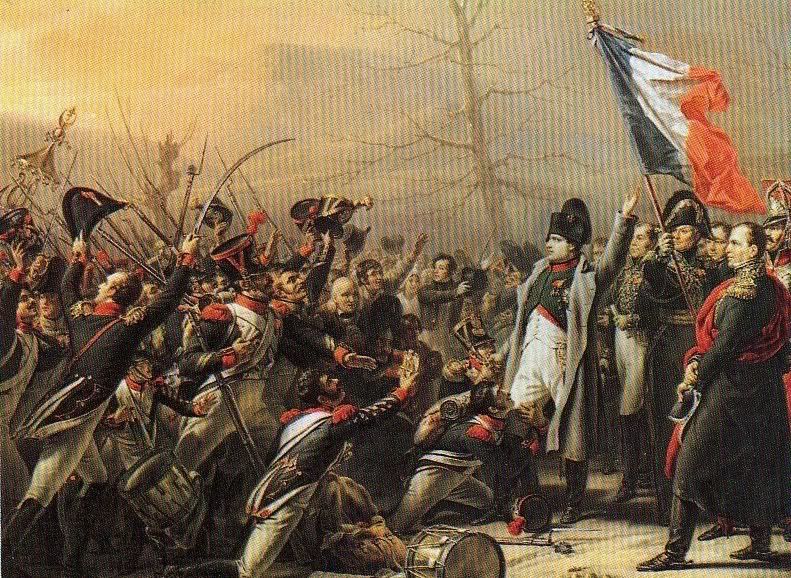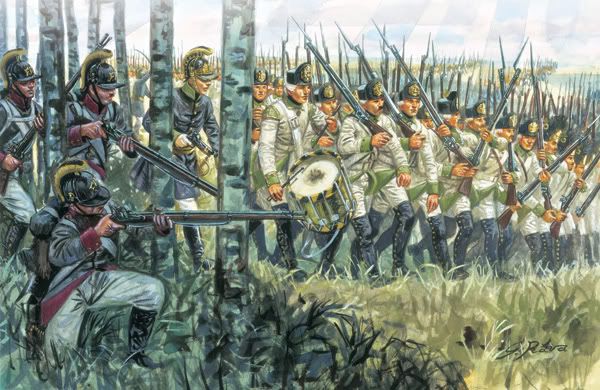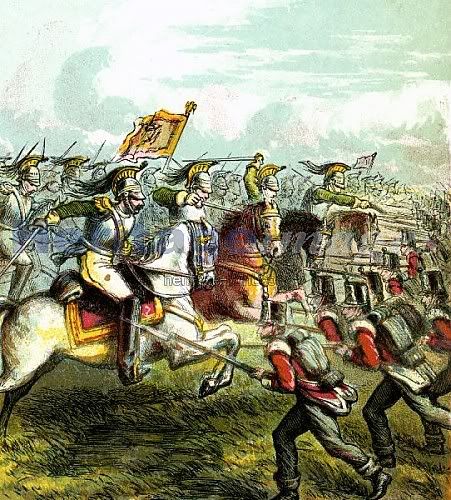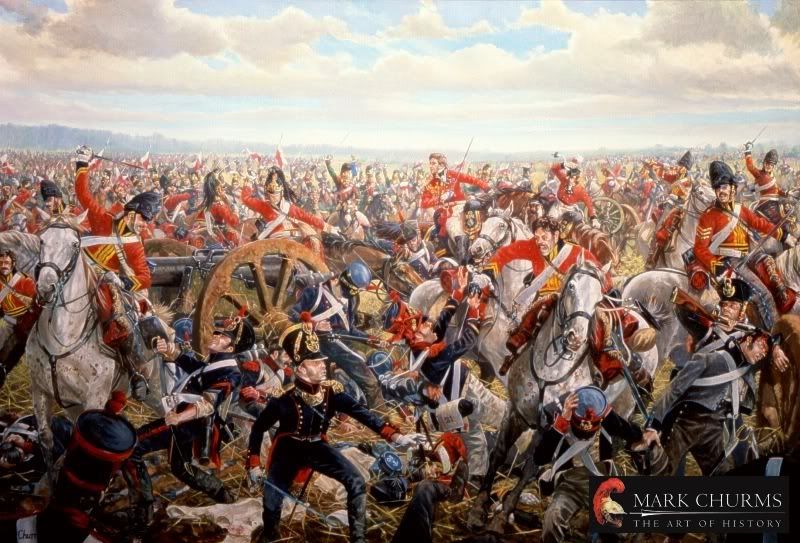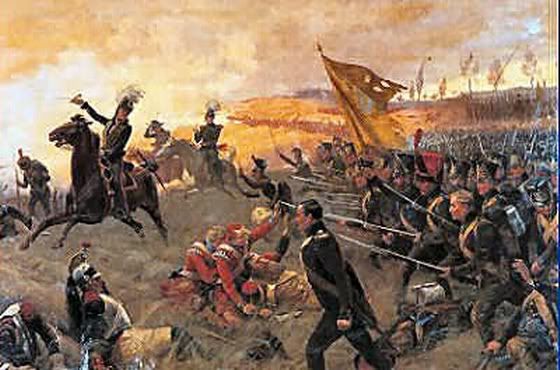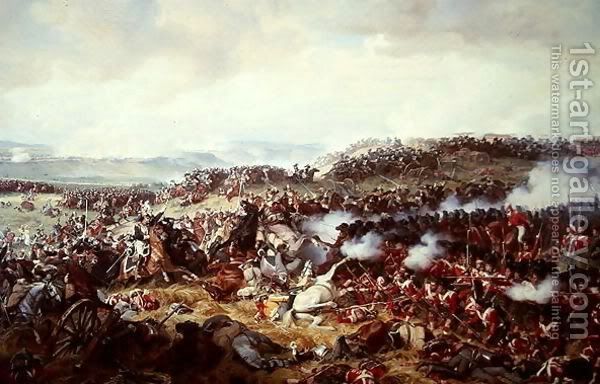The Great Russian War and The War of the Fourth Coalition

It did not take long following the Khan’s betrayal in April 1812 for Emperor Napoleon to realise that negotiation was no longer an option. In a remarkably short period of time he organised one of the largest armies ever assembled – by late June the 700,000 men of the Grand Armee were ready for battle. On June 24th Napoleon declared war against the Golden Horde and marched into the Horde’s domain.
It is sometimes said that in 1812 Napoleon invaded France merely to satisfy his own ambitions. Yet it is clear that this ambition for total European domination and victory over the British was ‘’the collective ambition of 30,000,000 Frenchmen’’.
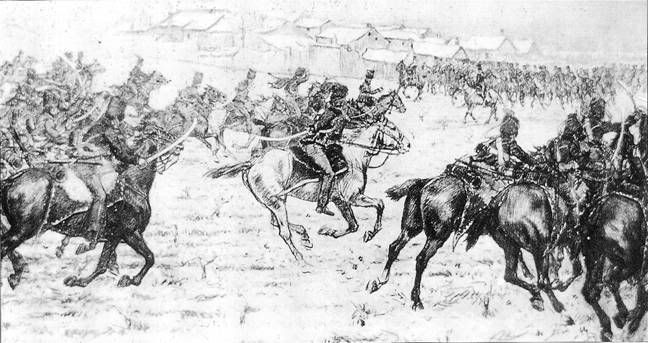
Engke Khan hoped to crush the French invasion before it had begun and on July 4th he sent the Horde to face the French Emperor. The resulting engagement resulted in an outright French victory as the Horde was utterly crushed and the Mongol Elite of the Khan’s army left slaughtered in the field. As the remnants of the Horde fled deeper into the Empire the European slave nations of the Mongol Empire all rose up in unison. It seemed that Napoleon had already won.
Yet the Khan proved too stubborn to negotiate and Napoleon was forced to continue his march deep into the Mongol Empire. The target of this march was Moscow – the capital of the Mongolian European provinces and the symbol of the Russian people. If it fell then Napoleon felt assured that Engke Khan would have no choice but to make peace and return to the Continental System.
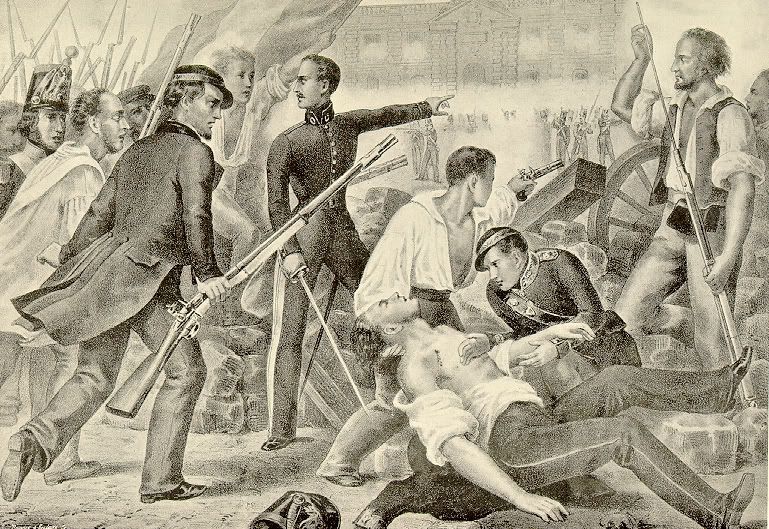
As the French advanced Russia descended into utter chaos. The Khan’s armies were so focussed upon Napoleon that they could do little to hold back the Revolution in Russia and the other European slave nations. However these Russians did not treat the French as liberators but as potential tyrants. A well known saying emerged in the chaos of 1812 ‘’we have been slaves of the Tartar, the Lithuanian and the Mongol. We shall not be slaves of the French!’’ The Russian partisans attacks the Grand Armee as much as the Horde.
The main obstacle to the French advance, however, was not the Russians but the scorched earth tactics employed by the Horde. As the French Emperor moved deeper into Russia the Horde travelled slightly ahead and they waste to all asunder.
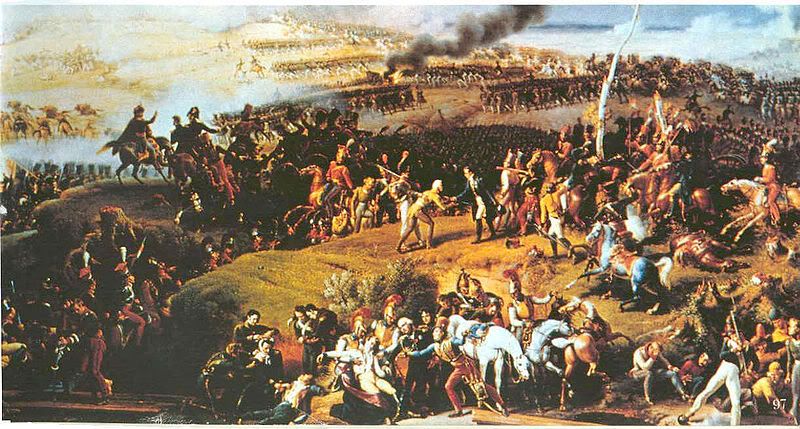
In September, when the Horde finally chose to meet Napoleon in battle once more, the two great armies faced each other at the Battle of Borodino near Moscow. The Horde had been topped up by the mass recruitment of mercenaries to replace the Mongol elite lost in the first engagement of the war and these new troops proved ineffectual. Once again the Horde was utterly crushed and fled from the field, this time headed straight for Astrakhan.
On September 14th Napoleon triumphantly arrived in Moscow. With the 2nd city of the Mongol Empire, behind only Astrakhan itself, now under his control Napoleon sent feelers to Engke Khan for his surrender. However they were utterly rebuffed.
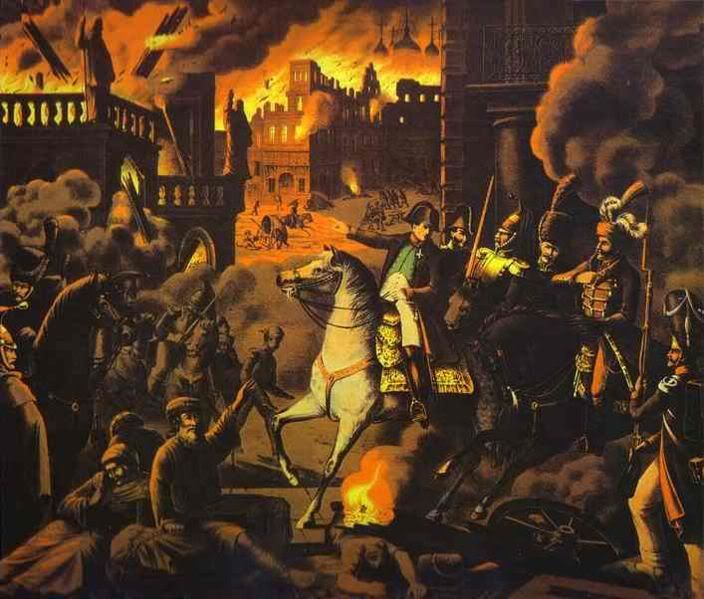
On September 15th, in an event that would stain Franco-Russian relations for decades, Napoleon lost control of his army and the great city of Moscow was sacked and set alight. By the time Napoleon and his army left ¾ of the city had been destroyed.

Following the capture of Moscow Napoleon led his army on a march South-East towards the Mongol capital of Astrakhan. Yet as he arrived at the Volga he was forced to turn around.
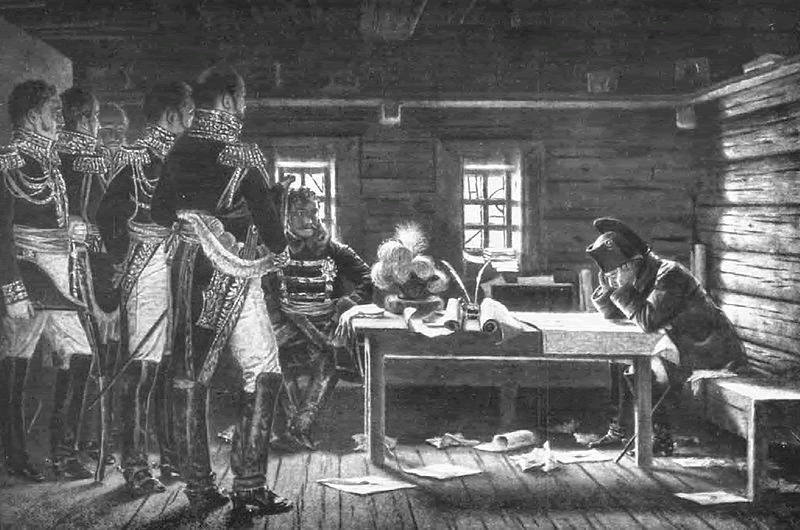
By the time it reached the Volga the Grand Armee was no longer so grand. Of the 700,000 men who had set off in June barely 100,000 remained. It was now mid-November and 1,000s were dying each week. As their Emperor tried desperately to secure total victory over Engke Khan the army mutinied. On November 14th a collection of Napoleon’s Marshals informed him that the army would not continue. As their Emperor despaired he said to have stated ‘’today the Empire has died’’.

So began the tired and destructive retreat back to Poland. When Napoleon arrived back on the Polish border in early February 1813 he came with just 30,000 of his original 700,000 man army. Seeing their opportunity to strike deep into Europe the Horde looked to meet the Emperor in battle once more. With a force bolstered by Poles and Hungarians Napoleon faced the 90,000 men of the Horde with around 50,000 French, Polish, German, Italian and Hungarian soldiers.
Yet again Napoleon showed his invincibility on the field of battle and crushed the Golden Horde once and for all yet the damage had already been done and by the time of his victory the Fourth Coalition had formed against him.
In Great Saxony Marshal von Blücher had launched a coup against Napoleon’s brother Lucien. Von Blücher then abolished the Kingdom of Great Saxony and established the Kingdom of Prussia in its stead with him as its first King. However in Vienna even more important events occurred.
As news filtered through to the Austrians of Napoleon’s defeat in Russia the Free Austrians knew the time was right to seize power. In January, just as the Grand Armee was approaching the Polish border, the Free Austrians launched their coup as loyalist soldiers captured the Hofburg and freed the popular Emperor Karl II. However at this stage Franz von Habsburg, the collaborator who had effectively ruled Austria since 1807, still held the reins of government and ordered the army to put down the revolt and restore the Emperor to his gilded cage. Yet these men refused to disobey their Emperor and instead joined Karl. With things quickly falling apart Karl’s supporters managed to capture Franz as he attempted to escape the Austrian capital and turned him over to the mob who subsequently tore him limb from limb. The Emperor then made an impassioned speech, lasting almost and hour, to the Vienna mob calling upon them for war: ‘’Austrians, Germans arise! Never again shall our brave people be slaves, never again shall Austrians cower whilst there is a victory to be one, never again shall a foreign army march in Vienna’s streets! Now Austrians to Glory! Austrians to Victory! Victory! Hail!’’ Karl quickly gathered a formidable army and marched to meet his fellow Emperor.
Just as Germany rose up again France Arthur Wellesley won two key victories in Spain. The first at the Battle of Salamanca left the French army in Spain on the retreat and the second allowed him to capture Madrid and force King Joseph to flee to France. However the French continued to defend heroically even as they slowly withdrew towards the Pyrenees.
Watching on as his great Empire collapsed around him Napoleon abandoned the remnants of the Grand Armee in Poland and returned to France where he vowed to raise and even larger army – he was almost successful as when he returned to the field in early June his army numbered some 400,000 men (3/4 of which were French with the final quarter being unreliable Germans and Italians who fought reluctantly at best).

Napoleon’s greatest fear was allowing the powerful Prussian army to unite with the large Austrian army and so in June and July he launched a blistering campaign to prevent this. On June 28th he delivered a stinging defeat to Blücher at Lützen in which he inflicted around 20,000 casualties for 10,000 of his own. Then Marshal Davout fended off Karl at Liberec (Bohemia) just a few days later. At Liberec the casualties were minimal but Karl was prevented from joining with the Prussians. At this stage it seemed that Napoleon could possibly secure victory despite being outnumbered almost 2 to 1. However Davout, who had been tasked with trying to hold off Karl whilst Napoleon attempted to defeat the Prussians, relied heavily on German conscripts from Westphalia and other areas of Germany with over half his force being non-French. Over the course of July a mass exodus started to occur as many thousands of Germans began to either simply abandon the French army or defect to the Coalition. With Davout’s army in chaos Karl was able to cross the Sudeten Mountains and arrive in Saxony in early August.

Napoleon was forced to take the better part of his army away from the chase of Blücher, who had successfully avoided a major engagement since Lützen, to face Karl at the Battle of Dresden. Here around 135,000 elite French faced 210,000 Austrians. Karl seemed simply too eager to secure a victory and carelessly attacked Napoleon’s army several times despite the good defensive position of the French. As the Austrians began to waver Napoleon unleashed Marshal Murat.
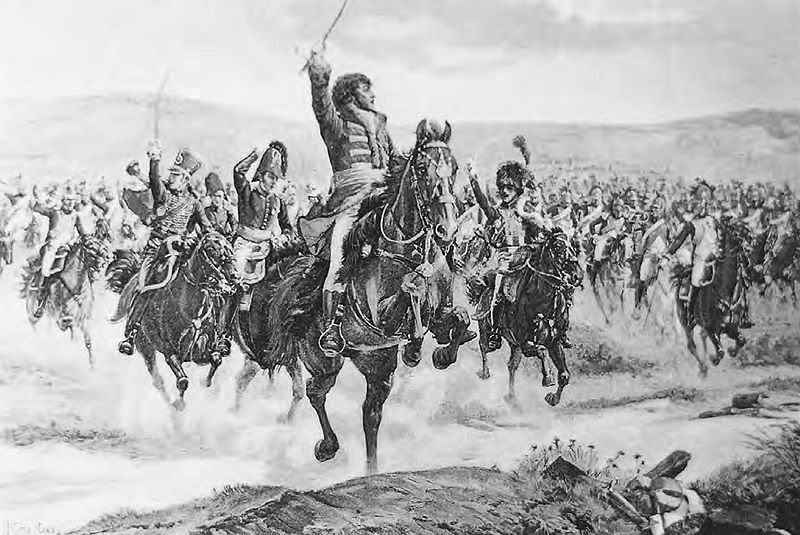
Marshal Murat’s cavalry charges have become a thing of legend and the charge at Dresden is perhaps his most successful. The aggressive and brilliant charge totally broke the Austrians and forced them to withdraw but also allowed Murat to claim a large portion of Karl’s artillery. At the end of the battle a full ¼ of the Austrian army had been captured or killed with 1/3 of Karl’s guns also falling to the French whilst between 10 and 20 thousand French were killed.
Frustratingly for Napoleon he gained next to nothing from his impressive victory at Dresden. Davout had been forced to totally abandon the Sudeten passes as Austrian troops stream through Bohemia to reinforce their Emperor meanwhile Blücher had successfully marched his army in Saxony from where he could support Karl.
The entire conflict would be decided in one single engagement – the Battle of Leipzig. The Battle of Leipzig was the largest battle in history until the Great War and remains one of the most decisive. Around 200,000 French soldiers attempted to defend the city of Leipzig from around 400,000 Prussian and Austrian troops as the city was assaulted from 3 sides.
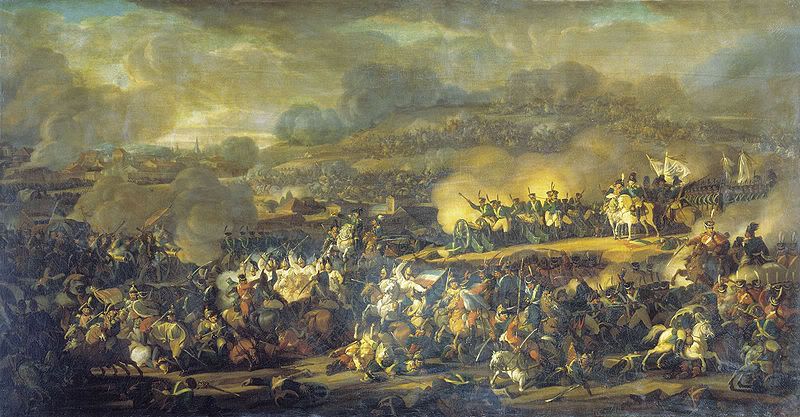
The battle was fought over a week in September and claimed over 100,000 lives from both sides. The French fought bitterly for every scrap of land and each hamlet as the German noose tightened around Leipzig and Napoleon desperately used every tactic he knew to try to maintain his power in Germany.
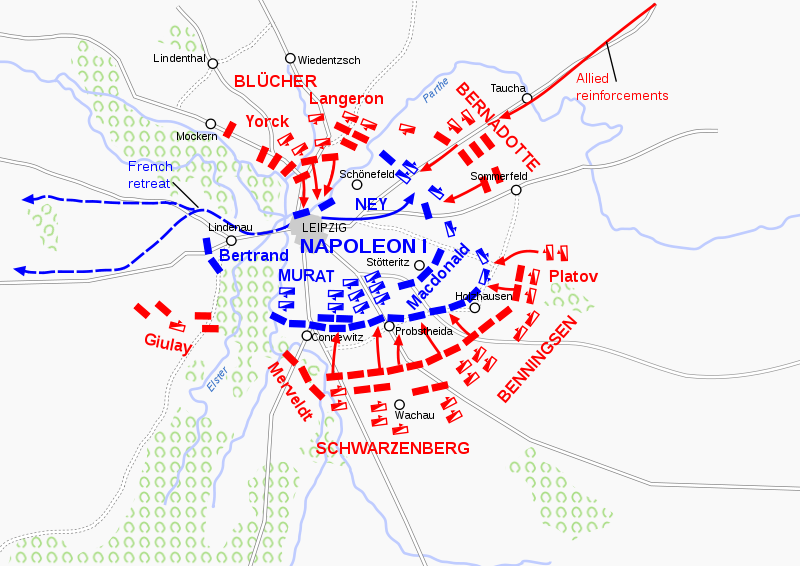
Yet by the 5th day of the battle his army was effectively broken and there was nothing he could do to hold onto Leipzig. On September 19th Napoleon and the survivors of the battle began to withdraw from the city. The French destroyed the rivers that lay immediately to the West of Leipzig to prevent the German armies following them and in doing so saved themselves from utter destruction.
Napoleon then began an orderly retreat Westward towards France, despite the best efforts of the Prussians and Austrians it never turned into a rout. Indeed Napoleon (with barely 20,000 men) defeated an Austrian army under general Shwarzenberg at Mainz which outnumbered his own force 4 to 1.
However it was clear that all was falling apart for the French. Wellesley crossed the Elbe into French territory in October 1813 and then the Pyrenees in December. Meanwhile the British landed an army in the Netherlands around the same time as they looked to liberate a friendly state that had risen in revolt following Leipzig.
By February the situation was beyond dire for France: Wellesley had taken much of Southern France including the cities of Toulouse and Bordeaux, other British forces occupied the Netherlands, Flanders and most of the key ports around France whilst both Blücher and Karl bore down upon Paris with large armies. By the second month of 1814 Napoleon had around 80,000 men to defend against more than half a million Coalition soldiers.
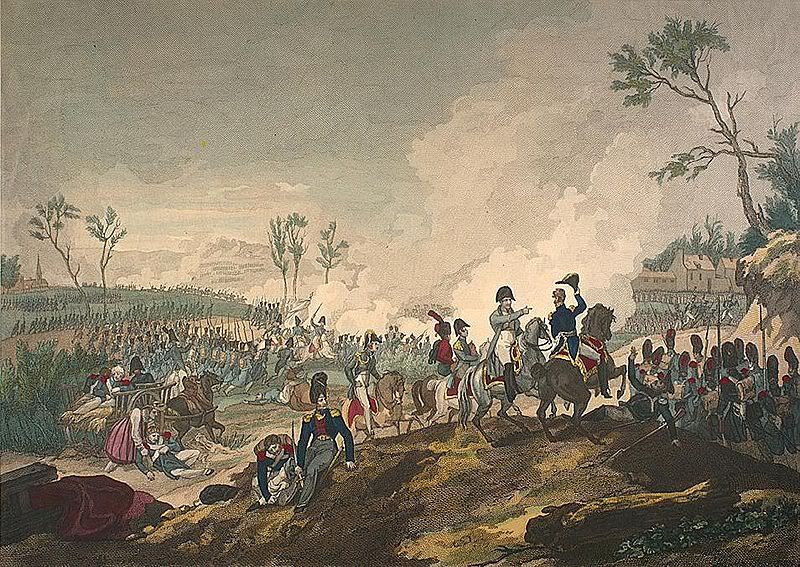
Yet the enigmatic Emperor refused to surrender. In the blistering and in many historians’ eyes the greatest campaign of Napoleon’s career the Emperor faced the 150,000 man Prussian army with barely 30,000 in the Six Day Campaign. Over the course of that short period Napoleon effectively defeated Blücher, who had looked certain to take Paris, and forced the Prussian army to totally regroup. Yet this campaign in mid-February only delayed the inevitable and instead of the Prussians it was Karl and his Austrian army that marched into Paris on March 30th. Despite this Napoleon tried to fight on by on April 4th he was presented with a mutiny in the ranks as the Generals called upon Napoleon to abdicate. Napoleon asserted that the army would follow him but Marshal Ney retorted ‘’the army shall follow its Generals’’. On April 6th 1814 Napoleon, Emperor of the French, abdicated bringing an effective end to the War of the Fourth Coalition.

It did not take long following the Khan’s betrayal in April 1812 for Emperor Napoleon to realise that negotiation was no longer an option. In a remarkably short period of time he organised one of the largest armies ever assembled – by late June the 700,000 men of the Grand Armee were ready for battle. On June 24th Napoleon declared war against the Golden Horde and marched into the Horde’s domain.
It is sometimes said that in 1812 Napoleon invaded France merely to satisfy his own ambitions. Yet it is clear that this ambition for total European domination and victory over the British was ‘’the collective ambition of 30,000,000 Frenchmen’’.

Engke Khan hoped to crush the French invasion before it had begun and on July 4th he sent the Horde to face the French Emperor. The resulting engagement resulted in an outright French victory as the Horde was utterly crushed and the Mongol Elite of the Khan’s army left slaughtered in the field. As the remnants of the Horde fled deeper into the Empire the European slave nations of the Mongol Empire all rose up in unison. It seemed that Napoleon had already won.
Yet the Khan proved too stubborn to negotiate and Napoleon was forced to continue his march deep into the Mongol Empire. The target of this march was Moscow – the capital of the Mongolian European provinces and the symbol of the Russian people. If it fell then Napoleon felt assured that Engke Khan would have no choice but to make peace and return to the Continental System.

As the French advanced Russia descended into utter chaos. The Khan’s armies were so focussed upon Napoleon that they could do little to hold back the Revolution in Russia and the other European slave nations. However these Russians did not treat the French as liberators but as potential tyrants. A well known saying emerged in the chaos of 1812 ‘’we have been slaves of the Tartar, the Lithuanian and the Mongol. We shall not be slaves of the French!’’ The Russian partisans attacks the Grand Armee as much as the Horde.
The main obstacle to the French advance, however, was not the Russians but the scorched earth tactics employed by the Horde. As the French Emperor moved deeper into Russia the Horde travelled slightly ahead and they waste to all asunder.

In September, when the Horde finally chose to meet Napoleon in battle once more, the two great armies faced each other at the Battle of Borodino near Moscow. The Horde had been topped up by the mass recruitment of mercenaries to replace the Mongol elite lost in the first engagement of the war and these new troops proved ineffectual. Once again the Horde was utterly crushed and fled from the field, this time headed straight for Astrakhan.
On September 14th Napoleon triumphantly arrived in Moscow. With the 2nd city of the Mongol Empire, behind only Astrakhan itself, now under his control Napoleon sent feelers to Engke Khan for his surrender. However they were utterly rebuffed.

On September 15th, in an event that would stain Franco-Russian relations for decades, Napoleon lost control of his army and the great city of Moscow was sacked and set alight. By the time Napoleon and his army left ¾ of the city had been destroyed.

Following the capture of Moscow Napoleon led his army on a march South-East towards the Mongol capital of Astrakhan. Yet as he arrived at the Volga he was forced to turn around.

By the time it reached the Volga the Grand Armee was no longer so grand. Of the 700,000 men who had set off in June barely 100,000 remained. It was now mid-November and 1,000s were dying each week. As their Emperor tried desperately to secure total victory over Engke Khan the army mutinied. On November 14th a collection of Napoleon’s Marshals informed him that the army would not continue. As their Emperor despaired he said to have stated ‘’today the Empire has died’’.

So began the tired and destructive retreat back to Poland. When Napoleon arrived back on the Polish border in early February 1813 he came with just 30,000 of his original 700,000 man army. Seeing their opportunity to strike deep into Europe the Horde looked to meet the Emperor in battle once more. With a force bolstered by Poles and Hungarians Napoleon faced the 90,000 men of the Horde with around 50,000 French, Polish, German, Italian and Hungarian soldiers.
Yet again Napoleon showed his invincibility on the field of battle and crushed the Golden Horde once and for all yet the damage had already been done and by the time of his victory the Fourth Coalition had formed against him.
In Great Saxony Marshal von Blücher had launched a coup against Napoleon’s brother Lucien. Von Blücher then abolished the Kingdom of Great Saxony and established the Kingdom of Prussia in its stead with him as its first King. However in Vienna even more important events occurred.
As news filtered through to the Austrians of Napoleon’s defeat in Russia the Free Austrians knew the time was right to seize power. In January, just as the Grand Armee was approaching the Polish border, the Free Austrians launched their coup as loyalist soldiers captured the Hofburg and freed the popular Emperor Karl II. However at this stage Franz von Habsburg, the collaborator who had effectively ruled Austria since 1807, still held the reins of government and ordered the army to put down the revolt and restore the Emperor to his gilded cage. Yet these men refused to disobey their Emperor and instead joined Karl. With things quickly falling apart Karl’s supporters managed to capture Franz as he attempted to escape the Austrian capital and turned him over to the mob who subsequently tore him limb from limb. The Emperor then made an impassioned speech, lasting almost and hour, to the Vienna mob calling upon them for war: ‘’Austrians, Germans arise! Never again shall our brave people be slaves, never again shall Austrians cower whilst there is a victory to be one, never again shall a foreign army march in Vienna’s streets! Now Austrians to Glory! Austrians to Victory! Victory! Hail!’’ Karl quickly gathered a formidable army and marched to meet his fellow Emperor.
Just as Germany rose up again France Arthur Wellesley won two key victories in Spain. The first at the Battle of Salamanca left the French army in Spain on the retreat and the second allowed him to capture Madrid and force King Joseph to flee to France. However the French continued to defend heroically even as they slowly withdrew towards the Pyrenees.
Watching on as his great Empire collapsed around him Napoleon abandoned the remnants of the Grand Armee in Poland and returned to France where he vowed to raise and even larger army – he was almost successful as when he returned to the field in early June his army numbered some 400,000 men (3/4 of which were French with the final quarter being unreliable Germans and Italians who fought reluctantly at best).

Napoleon’s greatest fear was allowing the powerful Prussian army to unite with the large Austrian army and so in June and July he launched a blistering campaign to prevent this. On June 28th he delivered a stinging defeat to Blücher at Lützen in which he inflicted around 20,000 casualties for 10,000 of his own. Then Marshal Davout fended off Karl at Liberec (Bohemia) just a few days later. At Liberec the casualties were minimal but Karl was prevented from joining with the Prussians. At this stage it seemed that Napoleon could possibly secure victory despite being outnumbered almost 2 to 1. However Davout, who had been tasked with trying to hold off Karl whilst Napoleon attempted to defeat the Prussians, relied heavily on German conscripts from Westphalia and other areas of Germany with over half his force being non-French. Over the course of July a mass exodus started to occur as many thousands of Germans began to either simply abandon the French army or defect to the Coalition. With Davout’s army in chaos Karl was able to cross the Sudeten Mountains and arrive in Saxony in early August.

Napoleon was forced to take the better part of his army away from the chase of Blücher, who had successfully avoided a major engagement since Lützen, to face Karl at the Battle of Dresden. Here around 135,000 elite French faced 210,000 Austrians. Karl seemed simply too eager to secure a victory and carelessly attacked Napoleon’s army several times despite the good defensive position of the French. As the Austrians began to waver Napoleon unleashed Marshal Murat.

Marshal Murat’s cavalry charges have become a thing of legend and the charge at Dresden is perhaps his most successful. The aggressive and brilliant charge totally broke the Austrians and forced them to withdraw but also allowed Murat to claim a large portion of Karl’s artillery. At the end of the battle a full ¼ of the Austrian army had been captured or killed with 1/3 of Karl’s guns also falling to the French whilst between 10 and 20 thousand French were killed.
Frustratingly for Napoleon he gained next to nothing from his impressive victory at Dresden. Davout had been forced to totally abandon the Sudeten passes as Austrian troops stream through Bohemia to reinforce their Emperor meanwhile Blücher had successfully marched his army in Saxony from where he could support Karl.
The entire conflict would be decided in one single engagement – the Battle of Leipzig. The Battle of Leipzig was the largest battle in history until the Great War and remains one of the most decisive. Around 200,000 French soldiers attempted to defend the city of Leipzig from around 400,000 Prussian and Austrian troops as the city was assaulted from 3 sides.

The battle was fought over a week in September and claimed over 100,000 lives from both sides. The French fought bitterly for every scrap of land and each hamlet as the German noose tightened around Leipzig and Napoleon desperately used every tactic he knew to try to maintain his power in Germany.

Yet by the 5th day of the battle his army was effectively broken and there was nothing he could do to hold onto Leipzig. On September 19th Napoleon and the survivors of the battle began to withdraw from the city. The French destroyed the rivers that lay immediately to the West of Leipzig to prevent the German armies following them and in doing so saved themselves from utter destruction.
Napoleon then began an orderly retreat Westward towards France, despite the best efforts of the Prussians and Austrians it never turned into a rout. Indeed Napoleon (with barely 20,000 men) defeated an Austrian army under general Shwarzenberg at Mainz which outnumbered his own force 4 to 1.
However it was clear that all was falling apart for the French. Wellesley crossed the Elbe into French territory in October 1813 and then the Pyrenees in December. Meanwhile the British landed an army in the Netherlands around the same time as they looked to liberate a friendly state that had risen in revolt following Leipzig.
By February the situation was beyond dire for France: Wellesley had taken much of Southern France including the cities of Toulouse and Bordeaux, other British forces occupied the Netherlands, Flanders and most of the key ports around France whilst both Blücher and Karl bore down upon Paris with large armies. By the second month of 1814 Napoleon had around 80,000 men to defend against more than half a million Coalition soldiers.

Yet the enigmatic Emperor refused to surrender. In the blistering and in many historians’ eyes the greatest campaign of Napoleon’s career the Emperor faced the 150,000 man Prussian army with barely 30,000 in the Six Day Campaign. Over the course of that short period Napoleon effectively defeated Blücher, who had looked certain to take Paris, and forced the Prussian army to totally regroup. Yet this campaign in mid-February only delayed the inevitable and instead of the Prussians it was Karl and his Austrian army that marched into Paris on March 30th. Despite this Napoleon tried to fight on by on April 4th he was presented with a mutiny in the ranks as the Generals called upon Napoleon to abdicate. Napoleon asserted that the army would follow him but Marshal Ney retorted ‘’the army shall follow its Generals’’. On April 6th 1814 Napoleon, Emperor of the French, abdicated bringing an effective end to the War of the Fourth Coalition.


